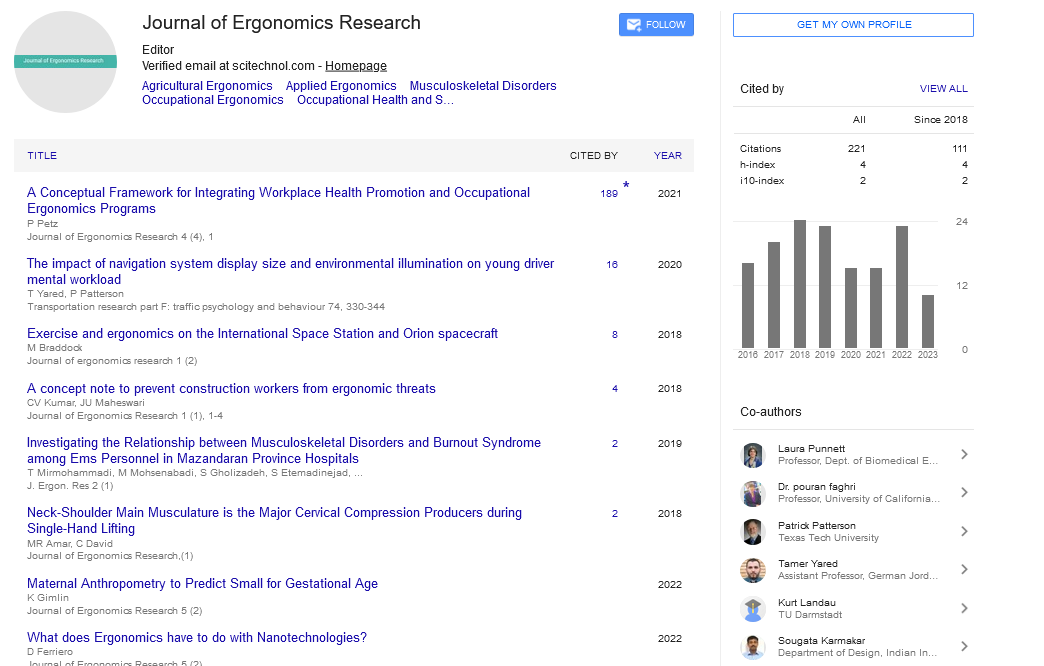Editorial, J Ergon Res Vol: 4 Issue: 6
Current Advances and Novel Research on Minimal Invasive Techniques for Musculoskeletal Disorders
Jonhatan Magno*
Federal University of Alagoas, Department of Physical Therapy, Alagoas, Brazil
- Corresponding Author:
- Jonhatan Magno
Federal University of Alagoas, Department of Physical Therapy, Alagoas, Brazil
Tel: +55282643746;
E-mail: Magno 62@gmail.com
Received date: 07 November, 2021; Accepted date: 22 November, 2021; Published date: 30 November, 2021
Keywords: Neuroergonomics, Occupational Hygiene, Physiology
Editorial Note
Once assessment and planning have been completed, including analysis of the collected data, the coming step is enforcing the strategies and interventions that will comprise the plant health program. The intervention descriptions for work related musculoskeletal diseases include the public health substantiation base for each intervention, details on designing interventions related to work related musculoskeletal diseases and links to exemplifications and coffers. Before enforcing any interventions, the evaluation plan should also be developed. Implicit birth, process, health issues, and organizational change measures for these programs are listed under evaluation of forestallment programs. In 1997 the centers for disease control and prevention’s National Institute for Occupational Safety and Health (NIOSH) released a review of substantiation for work related MSDs. Exemplifications of work conditions that may lead to WMSD include routine lifting of heavy objects, diurnal exposure to whole body vibration, routine overhead work, work with the neck in habitual flexion position, or performing repetitious forceful tasks. This report linked positive substantiation for connections between work conditions and MSDs of the neck, shoulder, elbow, hand and wrist and back.
Arthritis
The term arthritis is used to describe further than 100 rheumatic conditions and conditions that affect joints, the napkins which compass the joint and other connective towel. The pattern, inflexibility and position of symptoms can vary depending on the specific form of the complaint. Forty-six million Americans report that a croaker told them they've arthritis or other rheumatic conditions. Arthritis is the most common cause of disability in the United States. Arthritis limits the conditioning of nearly 19 million grown-ups. Two thirds of individualities with arthritis are under age 65. The national arthritis data working group estimates that 27 million grown-ups have osteoarthritis. Nine million grown-ups report characteristic knee osteoarthritis and 13 million report characteristic hand osteoarthritis. Persons are considered to have characteristic osteoarthritis if they've frequent pain in a joint and radiographic substantiation of osteoarthritis in that joint, although occasionally this pain may not actually radiate from the arthritis seen on the radiograph. Other forms of arthritis include rheumatoid arthritis and gout. Arthritis is a concern in the plant both because it may develop from work related conditions and because it may bear worksite acclimations for workers with limitations or disabilities. Early opinion and applicable operation of arthritis can help people with arthritis drop pain, ameliorate function, stay productive, and lower health care costs. Applicable operation includes consulting with a croaker and tone operation education programs to help educate people with arthritis ways to manage arthritis on a day to day base. Physical exertion and weight operation programs are also important tone operation conditioning for persons with arthritis.
Ergonomics is the wisdom of befitting plant conditions and job demands to the capability of the working population. The thing of ergonomics is to reduce stress and exclude injuries and diseases associated with the overuse of muscles, bad posture, and repeated tasks. A plant ergonomics program can aim to help or control injuries and ails by barring or reducing worker exposure to WMSD threat factors using engineering and executive controls. PPE is also used in some cases but it's the least effective plant control to address ergonomic hazards. Threat factors include awkward postures, reiteration, material running, force, mechanical contraction, vibration, temperature axes, light, shy lighting, and duration of exposure. For illustration, workers who spend numerous hours at a workstation may develop ergonomic-affiliated problems performing in musculoskeletal diseases.
 Spanish
Spanish  Chinese
Chinese  Russian
Russian  German
German  French
French  Japanese
Japanese  Portuguese
Portuguese  Hindi
Hindi 